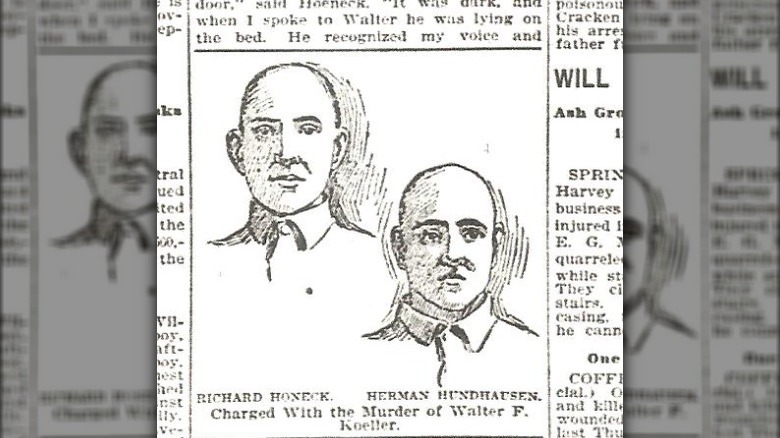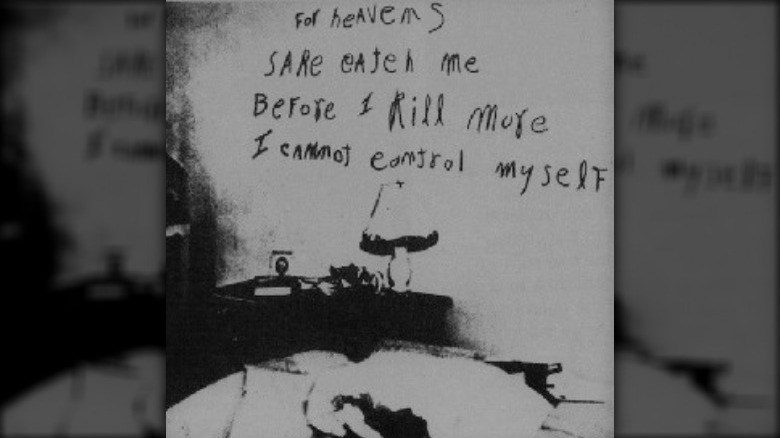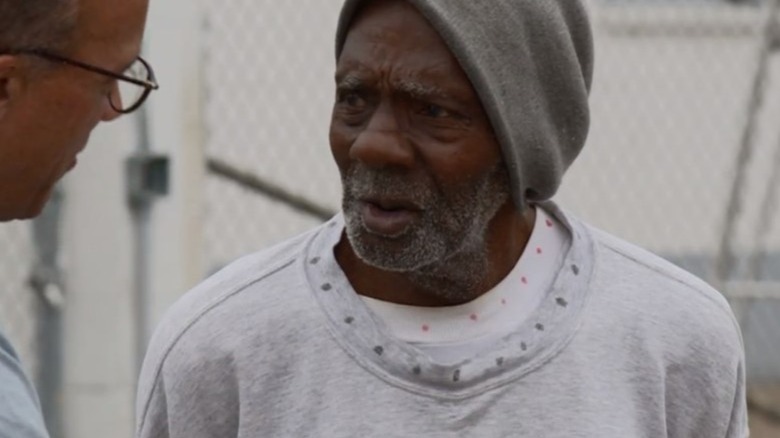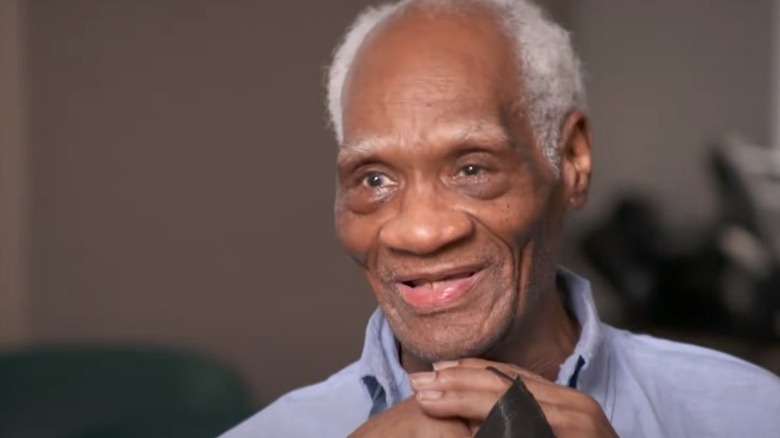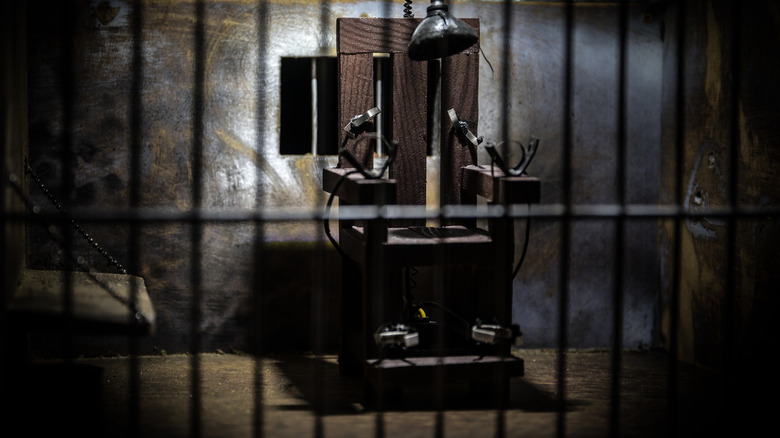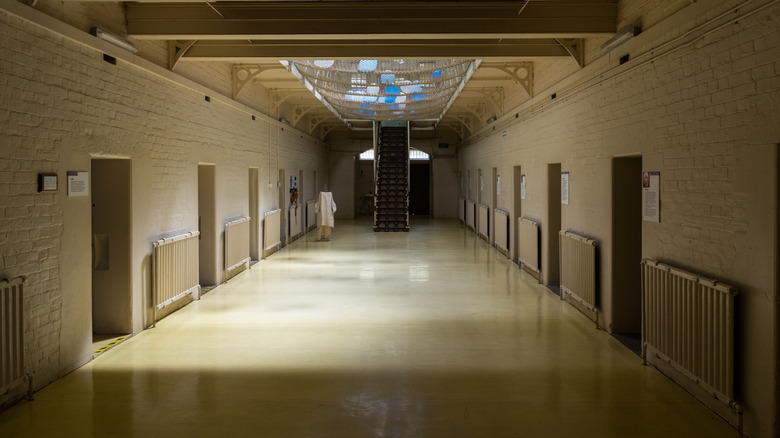These Are The Longest Prison Sentences Ever Served
The longest prison sentence ever given out was handed to one of the most unlikely people: Thai Petroleum Authority employee and military wife Chamoy Thipyaso. She, says History Collection, ran a pyramid scheme that defrauded about 16,000 people out of hundreds of millions of dollars and was given a prison sentence of 141,078 years. Sure, it sent a message, but Thai law meant she could only actually spend 20 years in jail, and she ultimately served just eight.
Sometimes, long sentences within the U.S. prison system are given as a sort of message for future parole hearings. Dudley Wayne Kyzer was found guilty of killing three people in 1976: his wife, his mother-in-law, and a college student who happened to be in the wrong place at the wrong time. According to the Tuscaloosa News, he was given a whopping two life sentences and another 10,000 years. He's obviously not going to live that long, so why even bother? For a terrifying reason: The jury wanted to make sure that anyone who considered freeing him would know just what kind of person they'd found him to be. So, what were the longest sentences that were actually served? The truth is pretty shocking, and not always for obvious reasons.
Patricia Krenwinkel
The time Patricia Krenwinkel has served behind bars doesn't come within decades of the longest-serving inmates. Her case is still worth talking about, though, as she's one of the longest-serving female inmates in the country.
In 2016, the Los Angeles Times reported that she was up for parole — again. Having been behind bars since 1971, she had earned the dubious honor of being California's longest-term female prisoner. And that kind of makes sense, as she was one of the followers that Charles Manson sent out with instructions to kill. According to CNN, she was convicted (in part) of stabbing Folger coffee heiress Abigail Folger 28 times.
When her parole was denied yet again in 2022, she hit her 53-year mark behind bars. In spite of the fact that the parole board lauded her rehabilitation efforts — which included things like having a clean record, volunteering for positions like training service dogs, and getting her bachelor's degree — it was ultimately determined that she was still a threat to society. The board explained that she still didn't show remorse but did display antisocial characteristics. As "a significant contributor to the violence and tragedy that became the Manson Family's legacy," she would remain behind bars.
Howard Christensen
When Howard Christensen died in 1999, he'd spent the last three years of his life in a nursing home. Prior to that, The Dispatch-Argus reported that he'd been the longest-serving prisoner in the country, after starting his jail term with a murder conviction when he was just 17 years old.
The Capital Journal recounted the path he'd taken to get there, saying that it started when he and friend Norman Westberg decided they were going to leave Chicago for the less policed wilds of South Dakota. The plan was to steal one of the cars that stopped to pick them up as they hitchhiked their way west, and the unfortunate good Samaritan was a teacher named Ada Carey.
Carey fought back and survived being shot twice and hit in the head with a hammer — long enough to give a statement about her attackers, at least. The two were arrested, arraigned, and convicted in 1937. While Westburg died by suicide in 1943, Christensen went on to hand out decades of misery to those around him. According to the Associated Press, he had a history of bad behavior and was a nightmare prisoner. He ultimately had his sentence commuted to time served and died having spent 58 of his 79 years in jail.
If you or anyone you know is having suicidal thoughts, please call the National Suicide Prevention Lifeline by dialing 988 or by calling 1-800-273-TALK (8255).
Richard Honeck
Richard Honeck's confession was recorded in the September 5, 1899 issue of The New York Times, which — in a surprisingly brief blurb — described the murder that had been years in the making.
Honeck and his accomplice Herman Hundhausen had been arrested in connection with a series of fires that had been set in Herman, Missouri. Among those who testified against them was a former classmate named Richard Koeller, and Honeck and Hundhausen not only vowed revenge but carried it out. Koeller was stabbed and killed in retribution for his testimony, and their plan for escape — created with the help of dime novels — didn't really pan out as they'd planned.
Honeck headed to jail, and it wasn't until December 20, 1963, that he was released on parole — and it was the end of a 64-year-long sentence. Newspaper reports (via Find A Grave) say that he was released into the custody of his niece and had been shocked at the way the world had changed while he was locked up. One of his duties had, for years, been slicing the prison's daily bread, so when he went to a grocery store and saw that it all came pre-sliced, it was nothing short of incredible. A respectable 85 years old at his release, Honeck died in 1976 at the age of 97.
William Heirens
In 1945, Chicago became the site of some grisly murders: Josephine Ross was killed first, and when Francis Brown was discovered, law enforcement found something else. That, says The New York Times, was a message scrawled on the wall in lipstick. It read, "For heaven's sake catch me before I kill more. I cannot control myself."
Two weeks later, the dismembered remains of 6-year-old Suzanne Degnan were discovered, and it wasn't until six months later that police arrested William Heirens for a separate burglary. His fingerprints matched those that were left at the Degnan home, and he would ultimately confess. Heirens was sentenced to life, and he would continue to maintain that he had confessed only to make sure the death penalty wasn't an option. Chicago says that just started the slew of questions around his guilt or innocence, and adding fuel to the fire were rumors that the message that led to the moniker "The Lipstick Killer" hadn't been left by the killer at all, and was instead the work of an overzealous reporter looking to increase the buzz around the story.
Still, questions weren't enough. Parole hearings — always attended by Degnan's family — sent him back to jail, and when he died at the Dixon Correctional Center in 2012, he was 83 years old and had been in jail for just over 65 years.
Warren Nutter
Warren Nutter was 18 years old when he was arrested by Iowa police in connection with a 1956 gas station robbery. According to Newsweek, Nutter escaped through a bathroom window and returned — with a shotgun — to free his accomplices. During the prison escape, he shot and killed Officer Harold Pearce, and after his re-arrest, trial, and conviction for first-degree murder, he became the youngest person ever given the death penalty in Iowa.
Nutter's sentence didn't stand for long, and just a year later, it was changed to life amid his attorney's arguments that he had grown up in the sort of home that didn't give him much of a chance of staying on the right side of the law. (According to Radio Iowa, his case was one of the reasons for the push to end the state's death penalty nine years after his conviction.) Nutter did, indeed, spend the rest of his life in prison. When the Associated Press (via the Des Moines Register) reported that he had died in December 2021, he was 84 years old and had spent more than 65 years in jail.
Sammie Robinson
In 2019, Dateline went inside Angola prison to talk to its longest-serving inmate. That was Sammie Robinson, who was 16 years old when he was arrested and convicted of aggravated rape in 1953. The following year, he killed another inmate, and his sentence became life without parole.
It wasn't the only interview he gave, and The Guardian says he also gave an interview for a documentary called "The Visiting Room." In it, he spoke about the years spent in what was, at the time, widely known as one of the nation's most violent and dangerous prisons. "I don't know how I survived. I had a tough time," he said, describing how he was locked in his cell, doused with lighter fluid, and set on fire. Robinson suffered third-degree burns over a good percentage of his body. "I'm lucky to be living now," he said.
When he was asked what he wanted, he said simply that he wanted to be out: "I could go somewhere and make me a living, I could start all over again," he said. "They say that the older you are, the more you know, and I know a lot of things." He was 81 years old at the time, and he didn't get his wish. He died in 2019, at 83 years old, having spent the previous 66 years in jail. His death came decades after a 1970 bombshell: His original conviction had been thrown out.
Johnson VanDyke Grigsby
When the guards told Johnson VanDyke Grigsby that he needed to pack his few belongings because his parole had been granted, he said that he didn't believe it at first. That's understandable: The year was 1974, and he had been in jail for 66 years. Ebony talked to him for a piece that ran the year after he was released, and at the time, the 89-year-old was living in another institution. This time, it was a nursing home — ironically, it was just a stone's throw from his previous residence at the Indiana State Penitentiary.
Grigsby had been charged with and convicted of second-degree murder after a man ended up dead in an Indiana saloon. The year was 1908, they'd been playing cards, and the man had accused Grigsby of cheating. So, he'd gone and gotten his knife out of pawn, and recalled, "The man was a crazy man. He couldn't be talked to. Stayed at the bar like a crazy man or something, instead of getting to a hospital. He was a fool, is what he was. Why, everybody knew that."
Grigsby's time in prison wasn't uneventful — John Dillinger had offered to take him with them when they broke out of jail, but he declined — and on the outside, he had no one. Exactly what happened to him isn't clear, although Genealogy says he died in 1987.
Walter Bourque
Walter Bourque's story isn't complete yet. Sentenced to anywhere between 18 years to life in prison in 1955, he's still in jail. According to Boston.com, the last time he was outside of prison walls was on a 72-hour leave in 1979, and they also noted that he really didn't care about getting out now that so much time had passed. That's not to say, though, that he didn't have his chances.
Bourque was convicted of the murder of 4-year-old Patricia Johnson, and according to his own testimony, he killed her because he was afraid she was going to tell her parents that he had been sexually assaulting her. "I wish someone had come down the stairs and stopped me. I was scared of the father ... The whole time I've been here, I've been thinking about it." Bourque, reported the San Bernadino Sun, had been one of the volunteers in the search organized to try to find the toddler, finally confessing to two police lieutenants.
Seventeen at the time of the murder, Bourque's first shot at parole came in 1966. That was denied, but by 1977, preparations were being made to return him to society. That fell apart, however, when his conditional releases came with accusations that he'd had contact with minors that violated the conditions of his parole, and his last chance ended when he was caught after stealing a check. He headed back to jail, and as of 2022, he'd served 67 years.
Joseph Ligon
Born in Birmingham, Alabama, Joseph Ligon — and his mother, father, and two younger siblings — moved to Philadelphia when he was 13 years old. Just two years later, he would be starting a jail sentence that wouldn't end for another 68 years.
In an interview with the BBC, he said that he'd always been a bit of a loner. So when he started hanging out with a group of kids in 1953, he didn't even know their names to tell the police after a Friday night turned into one that changed the lives of everyone involved. Six people were wounded and two were dead, and Ligon always denied the murder charge he was convicted of. When his sentence was handed down, he wasn't even in court that day — he was just sent to jail. "I knew I had to do time, but I had no idea I'd be in prison for the rest of my life. I had never even heard the words 'life with parole.'"
Ligon was 53 years into his sentence when he met with an attorney who was trying to change the system and eliminate the possibility that juvenile offenders be given life sentences. At the time, Ligon still hadn't been told precisely what his sentence was. It was a long time coming, but The Washington Post reported in February 2021 that the now-83-year-old Ligon was free — after 68 years. His sister and niece were the only family he had left.
John Phillips
The North Carolina Department of Public Safety lists John Phillips' intake date as July 17, 1952, and his parole date as March 9, 2021. That means he served 69 years in jail, convicted of first-degree rape when he was 18 years old. As with many inmates, that only tells part of the story.
Born in 1934, The News & Observer reports that Phillips was arrested the day after the assault of a 4-year-old girl. When he was sent to a state hospital for an evaluation that would determine if he was capable of standing trial, it was determined that he was developmentally disabled. Being 1934, however, the report didn't say that: The report, in fact, ruled that he was a "moron." The opinion of the state facility meant that Phillips's lawyer entered his plea, which was "guilty." In spite of being found to have the intellectual and emotional age of a 7-year-old, he was given a life sentence.
In 1991, the News & Record spoke with him. He'd been behind bars for 39 years at that point, and told them, "This is my home. I'm going to be in prison until I die. ... Time doesn't worry me. I can make it longer. It don't make no difference to me." At the time, he had no record of major disciplinary actions and no visitors. Those who shared the prison with him knew him — affectionately — as Peanut.
Paul Geidel
Paul Geidel, says the New York Daily News, didn't have a great start in life. Born in 1894 and orphaned by the age of 7, he was 17 years old when he made his way to New York and started working as a bellhop at a high-end hotel. A few days after being fired, he procured some chloroform, broke back into the room of a retired Wall Street broker, and accidentally suffocated him during the attempted robbery.
Geidel, it turns out, had chosen his victim very poorly: He had been friends with Manhattan district attorney and future governor Charles Whitman. It's not entirely surprising, then, that Geidel was sentenced to 20-to-life, and when The New York Times looked at his case in 1974, he was not only still in prison, but he was okay with being there. "Sing Sing was a bad place when I got in there," he told them. "But I deserved it. I took a good man's life. Still to this day, I don't know how I could have done that."
The then-79-year-old Geidel first had his parole declined, and then — with a promise of housing and care from the Sea View Hospital and Home — his parole went through in 1980. He died at the nursing home in 1987, having spent 69 years in prison.
Francis Clifford Smith
In 2022, Greenwich Time reported that Francis Smith was a free man. That freedom came at the end of 72 years behind bars, and perhaps unsurprisingly, it wasn't exactly freedom. The 97-year-old Smith was released into the custody of a nursing home. And here's the thing: Those who have studied his case are pretty sure he was innocent the whole time.
Smith was born in 1924, and in 1949, he became wrapped up in a murder case that would lead to him spending more than seven decades behind bars. The shooting took place at Greenwich, Connecticut's Indian Harbor Yacht Club, and resulted in the death of a night guard named Grover Hart. Law enforcement knew they were looking for two shooters, and they picked up George Lowden first. Lowden took a plea deal and named Smith as his accomplice, but Lowden — who was given his own freedom in 1966 — later said that he'd been told to implicate Smith, who was known as one of the area's petty but unrelenting criminals. Another witness recanted her claim identifying Smith, and perhaps most importantly, another man confessed to being the second shooter.
Smith had initially been sentenced to death and was actually prepped for the electric chair within his final 24 hours on death row when he got the last-minute phone call changing his sentence to life. The parole board has reported no problems with him since his release.
Charles Foussard
Melbourne, Australia's The Argus reported the 1903 killing as "The Skye Tragedy." The victim was an elderly man named William Ford, and one of the key pieces of evidence was a missing pair of boots. The boots bore a makers' mark, a distinctive pattern, and a specifically reinforced heel. They also happened to be on the feet of 21-year-old Charles Foussard when he was arrested, initially on charges of vagrancy.
Foussard confessed to killing the man, and only a few days over a month later, The Argus reported that prosecutors argued that he was not competent to stand trial: "...the accused was of unsound mind and suffered from delusions." Escape reports that instead of a typical prison, Foussard was sent to the notorious J-Ward in Victoria's Ararat built in the late 19th century as an institution to house the criminally insane. While Foussard wasn't the only one to never again step beyond the asylum's walls, the length of his stay is undparalleled. A young, 21-year-old when he was arrested, put on trial, and sent there, he remained there until he died at the age of 92.



